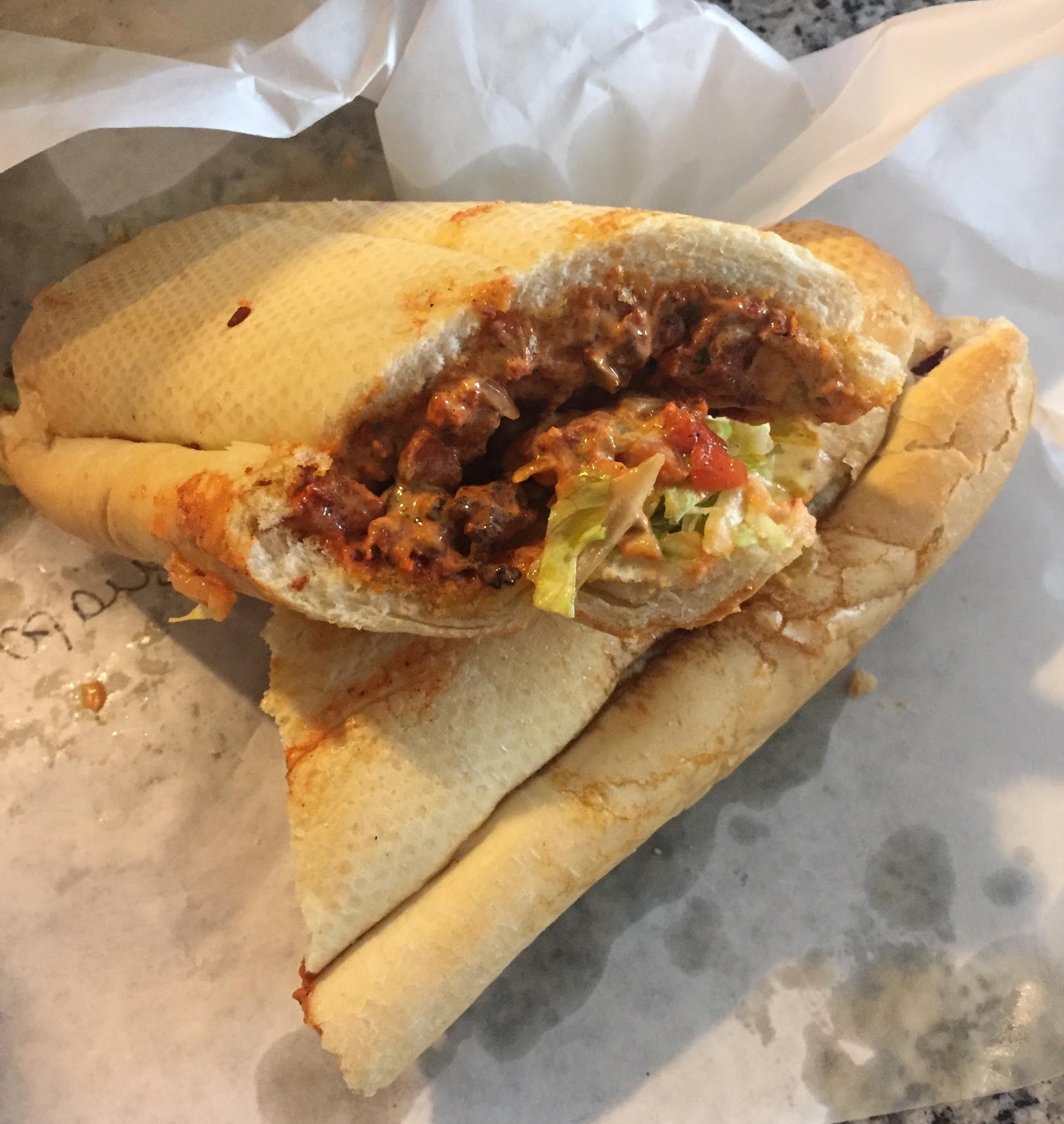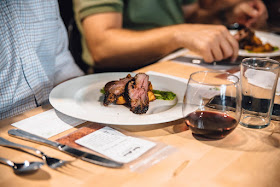by Drew Broussard, intern
The Poboy (Po’boy, Poorboy…?), where do I even begin? It is as important to Louisiana as festivals, Bourbon Street or hurricanes. It occupies an entire row on the metaphorical Cajun Food Pyramid. It is a bonafide staple of so many people’s diets, and I am no exception. From their humble beginnings as street food for New Orleans transit strikers in the early twentieth century, poboys have evolved into a sort of cultural (and epicurean) phenomenon. No matter where you are in Southern Louisiana, you are sure to be able to get your hands on one of these quality sandwiches. And it is with great enthusiasm that I encourage you to eat at every poboy stop that your stomach will allow. There are plenty of options. Oh, and trust me, no matter how many you have, they don’t get old.
It was on this very crusade that I happened to stumble into a small restaurant on the corner of Jefferson Street in Downtown Lafayette last summer. I agreed to meet friends at a new restaurant called Pop’s Poboys. We were set to journey on a two week camping trip the following day, and we were all in search of a parting meal, Louisiana style. When I first walked in, I could sense the trendiness. This place was like a plaid wearing, man-bunned hipster playing Ice Cream Paint Job on acoustic (excuse the hyperbole). It had it all: chalkboard menus, a self-service water station, and butcher’s paper on the tables! This wasn’t the greasy, grimy, country music type of poboy place that I was used to. This was poboys for millennials. Who was this “Pop,” guy anyway?

Even more questions popped into my head as I looked at the menu hanging from the wall above me. What was this place? I saw the classics, such as catfish, roast beef, and hot sausage, but what were these imposters? Meatball poboy, Nashville hot chicken poboy, red bean falafel poboy, where does it end?! I grew skeptical, but my friends at the table encouraged me to try something new. It was then that I first laid my eyes on the beast of a sandwich known as the Cajun Castro. Pulled pork, ham, cheese, stewed greens, AND fried pickles all on crispy french poboy bread. This wasn’t a cuban, but it wasn’t a poboy either. My curiosity overcame my doubts, and I went for the Castro along with a side of fried okra (you know, to keep things authentic). When it arrived at my table, I started to grow excited. I suppose that my stomach was overpowering my mind, because the juices seeping through that butcher paper containing the sandwich were having me feel some type of way. I peeled back the tape, unwrapped the thing like it was Christmas morning, and took a moment to behold what was in front of me. Forget about whether it was authentic or not, this thing looked GOOD. The crispy loaf gave way to creamy smothered greens that were seemingly struggling to bear the weight of all the meat on top of it. Cheese and fried pickles were on top of that, along with the top piece of the french bread that seemed like it had fully coped with the fact that it was never going to see its bottom half again. This thing was packed, and I dug in. The cajun pork tasted like it had been cooking for hours, and its fattiness was cut perfectly by the bold greens underneath. And despite the overwhelming juiciness, the bread and fried pickles managed to stay crispy enough to provide varied texture. There is a lot to be said for good bread on a poboy. I truly don’t know how, but I finished the thing. The flavors were too good to go to waste. Somehow, amidst all the internal conflict, I knew that I’d have to come back. Poboy or not, this place was too good to pass up. I could keep a secret from my Cajun forefathers, right?
Two weeks passed and I arrived back from my camping trip. It took less than twenty-four hours at home before I found myself looking through Pop’s glass doors once more. This time I was serving as the millennial ambassador to my parents as I led them through this New-Age poboy experience. This time around, I opted for the Hot Hot Chicken Poboy. One of the employees warned me that this Nashville style sandwich would bring the heat, but I was not afraid. Although I am usually skeptical of a restaurant’s judge of spice, this sandwich didn’t hold back. The homemade buttermilk ranch and house pickles cut the spice to the point where I can only describe the sensation in my mouth as, “hurts so good.” My parents were completely on board too after their experience. A Shrimp Bahn Mi Poboy is untraditional, but man, did my mom enjoy it! My dad had similar sentiments after chowing-down on the Cajun Castro, the one that started it all for me. After I realized that my parent’s, true poboy enthusiasts, had an incredible experience eating these non-traditional dishes, I started to wonder: does the tradition even matter?
Pop’s has since become the go-to spot for my friends and I anytime that we find ourselves in Lafayette. The uniqueness is too intriguing to pass up on. From the hamburger poboy with pimento cheese to the cheese fries with spaghetti noodles and pickled onions, I haven’t been led astray. Even their more adventurous weekly specials are a guaranteed home run. In fact, my absolute favorite sandwich from Pop’s is the El Guapo Cochon. Try not to salivate: crispy poboy bread with deep red, pastor style pork, pineapple pico di gallo, a sprinkling of queso fresco, and a little bit of spicy chipotle mayonnaise.
Sinful.
The El Guapo has got the perfect amount of spice, and the pineapple is just bright enough to register on the tastebuds. The queso fresco is a subtle yet crucial sprinkling of cheesy beauty on top. I could eat it every day, but unfortunately it's available only on a rotating weekly basis. With that being said, be sure to check out Pop’s Facebook, they keep it populated with all of their latest creations.

I’ve been an almost shameful amount of times to this place over the past year, and in that time I have achieved a bit of an ideological transformation. I used to believe that Louisiana’s cajun and creole culture is rooted in its ways, unchanging, settled. I thought that a poboy had only a handful of of variations that had been tried and tested over the course of generations. I couldn’t imagine the New Orleans street car workers enjoying a Nashville Hot Chicken version of their beloved sandwich, but this isn’t the late 1800’s. Pop’s has helped me realize that an area’s culture is living, no matter the number of references made to its past. No agent of culinary change would exist without there being an element of disruption, and Pop’s is that nontraditional force. The cajun cookbook is long and venerated, with the poboy claiming one of the largest chapters. But that cookbook is still being written, and I can promise you that Pop’s Poboys in Lafayette, Louisiana will be adding a few pages.


























